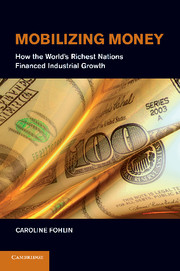Book contents
8 - Does Financial Structure Drive Industrial Growth?
Published online by Cambridge University Press: 05 January 2012
Summary
Economic historians have always underscored the influence of institutions – economic, political, legal, social, and even cultural – in the processes of industrial development and economic growth. In the last decade, economists more broadly have turned their attention to similar factors underlying the differential economic growth witnessed across countries. Much of the recent literature on the determinants of long-run economic growth focuses on financial institutions as critical factors. In particular, the current literature focuses on the role of political and legal systems in providing the environment that allows financial institutions to allocate capital and services efficiently. This literature takes as a given that functioning financial institutions are important preconditions for economic growth, which is sometimes called the finance-leads-growth perspective. In contrast, in the mid-twentieth century, the dominant view held that financial development responded to demand or real economic activity. The finance-leads-growth perspective has begun to hold sway, although some have recognized the dual directions of causality: In the long run, increases in industrial activity will feed back into the financial system, thereby increasing the demand for financial services. In this case, in the long run, the causality from economic growth to financial development goes both ways.
Financial development can imply a variety of processes and can envelop numerous different institutions. Fully functioning financial systems must do at least three basic things: provide credit for entrepreneurial projects, independent of personal connections; instill confidence in investors that they will earn a fair expected return; and spread risk across investment projects. A mature financial system should provide all of these services at a low cost. In economic terms, these conditions imply complete markets for insurance and financing based on market factors; low “outside risk” – that is risk associated with factors such as political or institutional instability (like political revolutions or bank failures); and low transactions costs for obtaining financial services, such as borrowing, securities issues, or insurance. Low transaction costs are typically also associated with the existence of arms-length financing opportunities as these can be competed for on merit, disclosure laws (i.e., transparency in financial deals), and contract enforcement that ensures creditor repayment or punishment. Several studies have offered evidence that this sort of financial development provides an impetus for economic growth. These studies have focused primarily on the past thirty years, however, and they therefore neglect the structures that have evolved over longer periods that may be more important for understanding why some countries grow faster than others.
- Type
- Chapter
- Information
- Mobilizing MoneyHow the World's Richest Nations Financed Industrial Growth, pp. 191 - 221Publisher: Cambridge University PressPrint publication year: 2011



